




Selected Works 2022-2025



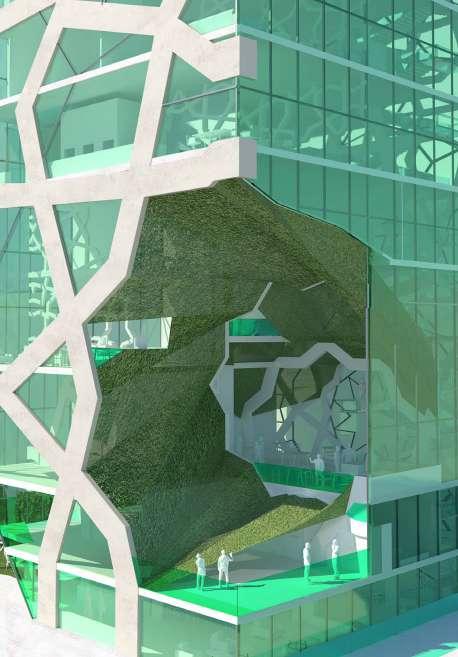

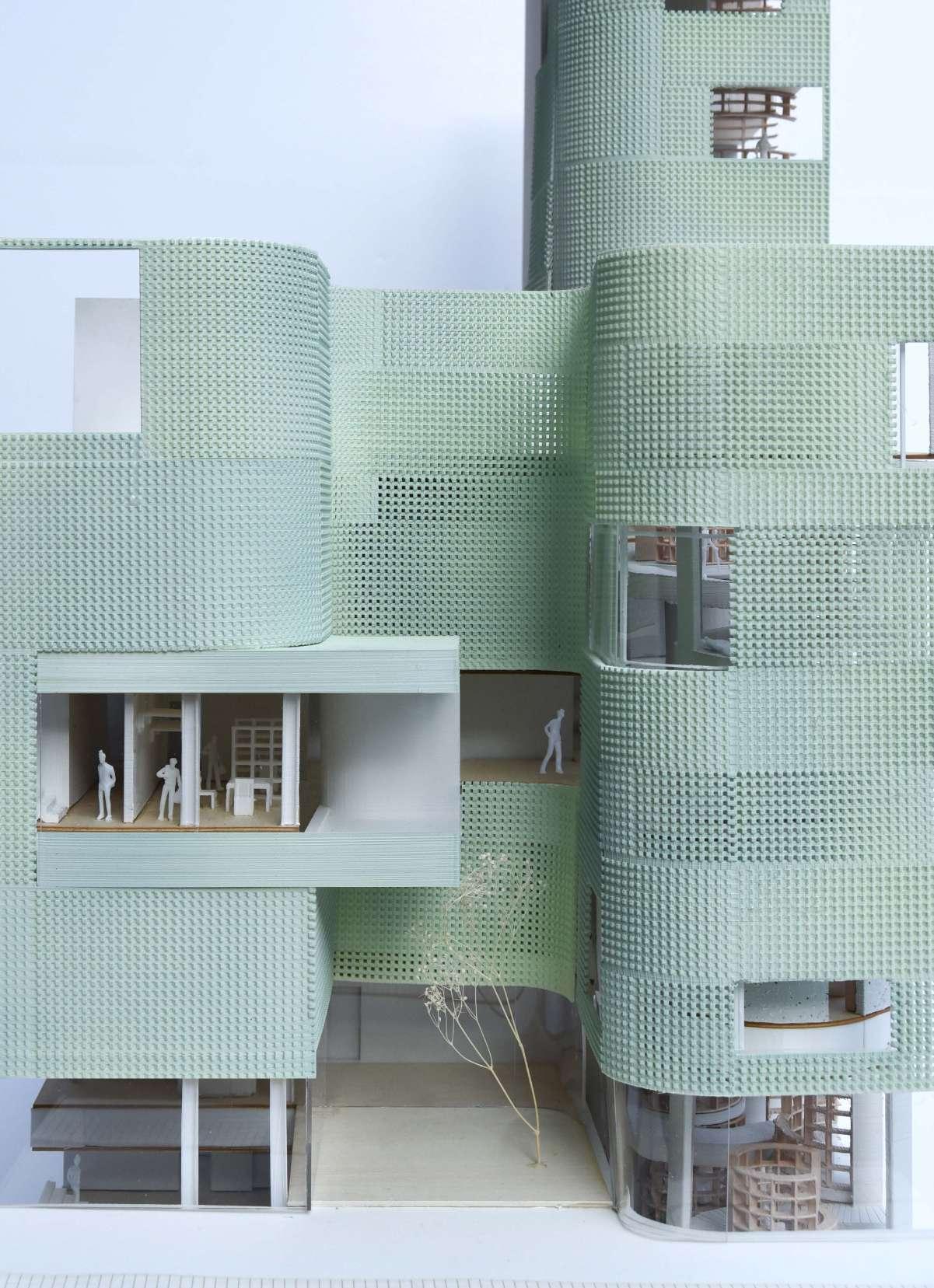
Library, Theater, Public Space

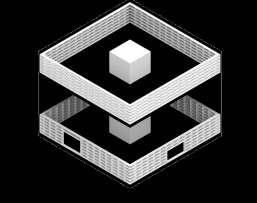

The objective of the project is to design a library incorporating a public theater, several rooms, and a peaceful reading space. Positioned adjacent to the corner, the reading area features a long display table, serving as a central focus for readers to peruse the shelves and immerse themselves in their selected materials. Utilizing primarily brick, the construction bathes the area in soft, diffused light. Conversely, the bookshelves are fashioned from wood, enhancing the project’s overall ambiance with a touch of natural warmth.
Overall, the design of the library embodies a thoughtful balance be- tween functionality and ambiance, creating a welcoming and inspiring space where the love of literature can flourish and community connections can thrive. Whether visiting to attend a public theater perfor- mance, explore the diverse collection of books, or simply enjoy a mo- ment of quiet reflection, patrons are sure to find solace and inspiration within its walls.


The ramp system connects to three major spaces in the library: Private Reading Rooms, The Internet Archive, and The Library Archive. These spaces are located in the tower area, providing a place for patrons to look up and meditate.

The facade showcases a gradient of brick, designed to bathe the interior in soft, diffused light, while wooden bookshelves introduce a touch of natural warmth. This juxtaposition creates a harmonious balance of engagement and tranquility. Curved openings invite light to pour in, highlighting the thoughtfully designed interior space.





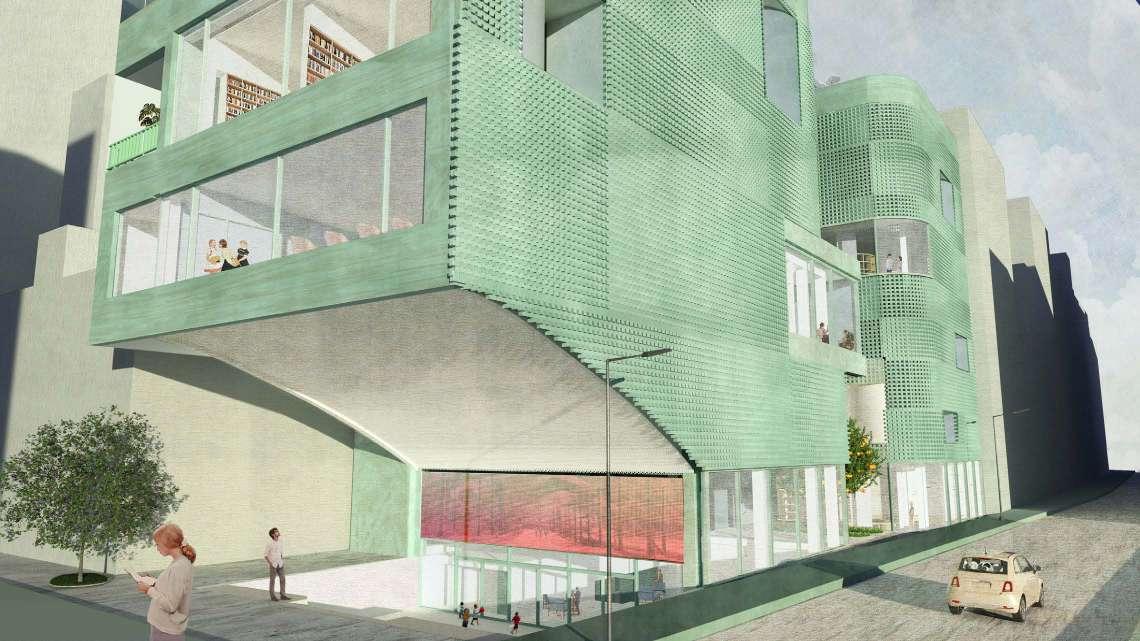
Library: Ways for Seeking
Archive: Points of Arrival





The library consists of a series of ramps that frame the reading area and shelving units. Visitors have the option to stand or sit with shelving screens, which allows people to fully experience the dynamic space shaped by ramps and shelves.








The project started by conceptualizing room taxonomy and modular system, where a self-repeated pattern was projected into unit devel- opment and form floor aggregation. The resulting repeated pattern modules seamlessly developed a curvy bar shape, allowing rotation and combination between individual units.The overlap of two curvy bar shapes provide courtyard condition,create opportunities for views and openings, and also separate the entrance between resident and pedes- trian who wants to enter the library. To enhance the project’s integra- tion with the site and establish a connection with the library, the design occupied the roof of the library, creating an elevated space from the ground level. The roof can be used as a public gathering, connected with multipose room in the back of the library. Two modular curvy bars, characterized by their repetitive design, generate multiple open- ings, allowing sunlight to illuminate the interior spaces. The spaces be- tween the shift of patterns(single loaded modular units) are designed as hallways that not only facilitate circulation but also offer captivat- ing views. These hallways connect to roof balconies, generating public spaces that serve as communal areas for the residents.





The design began with the development of five distinct room types to address the needs of a living room with a kitchen, bedroom, bathroom, and balcony. Through a series of assemblies, these rooms were combined to create shared living apartments using modular units, including studio apartments, 1B1B, 2B1B, and 4B1B configurations. With modular units, they can be assembled and connected in various ways, forming a continuous residential complex with a shared central hallway.


Each modular unit is configured in variations of 2B1B, 4B2B, and 1B1B layouts. Leveraging the geometric characteristics of hexagons and squares, some units feature shared balconies, creating communal spaces where residents can connect and interact. Additionally, the hallways include shared amenities such as storage areas, study rooms, and meeting spaces for residents on the same floor. The expansive green spaces provide areas for relaxation and recreation, offering a vibrant environment for the community to enjoy.

Shipping For Modular Units
There are several methods for transporting modular units to the site. A standard truck can accommodate a micro-unit or a studio space without requiring assembly. Thanks to the flexibility of the modular design, smaller components, such as single-bedroom modules, are packed onto trucks and assembled on-site. Once assembled, additional construction features, like the concrete arch façade, are added to complete the exterior.

The design elements respond to the program distribution, which are made up by three parts: public facility for farmers/visitors, Semi public facility for farmers/residents and private housing for residents. Each programs fit into the form just like puzzies, creating visiual and physical connection to the audience. The pedestrians are welcome to visit any places on the program map and see the showcase of nature.
Programs For the Public Common
Analysis of Programs
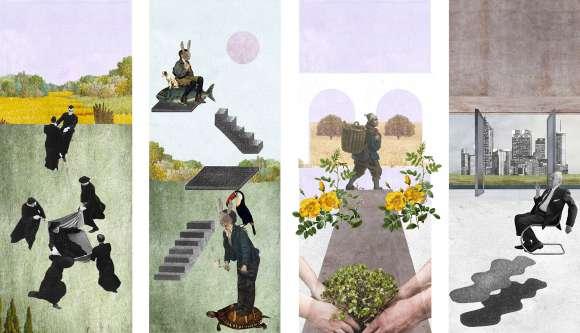

By spreated the old facade into two parts, creating a new opening that contain the same size/feature of the





Design a double-height space to accommodate a horizontal balcony, providing an elevated platform for a unique and expansive outdoor experience.

Arrange identical units in a stacked configuration, utilizing arches to occupy the balcony areas and creating a layered effect with elongated arch windows.

Introduce staggered placement to the residential units, stacking them with pattern.

The modular unit construction commenced by connecting Superior Wall components with a pre-fabricated connector. Subsequently, a clip-on concrete facade was added, featuring a series of arches that introduced dynamic structural elements. The installation concluded with placing a Concrete Arched Roof Panel. The open arch columns facilitate setbacks and balconies for residential units. A comparable approach is also evident in the public common areas, where larger span columns support the foundational structure.

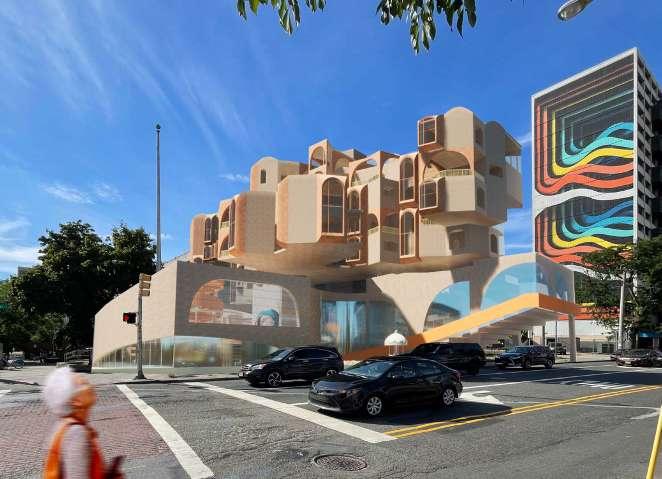



Gentrification, Playful, Deconstruction Studio 502 Individual Project

An elderly Chinese immigrant who had recently arrived in the Unit- ed States expressed, “I am new to this country and cannot understand English. I require Chinatown to buy essentials, seek medical attention, and translate English mail.” As a first-generation immigrant, They need a place to call home, where they feel a sense of belonging. The hardships of home- lessness, poverty, and displacement that immigrants often face can have a significant impact on their mental health, and they frequently lack a support system to turn to for even the simplest things.
To address these challenges, there is a critical need for public education workshops that support the well-being of multigenerational and multicul- tural communities. These workshops can focus on strategies for cultural adaptation, healthy parenting, and stress management to provide resources and support to those who need it most. To create an environment condu- cive to these goals, a three-zone self-generated island design can be imple- mented, specifically designed to address and resolve the issues faced by new immigrants. Furthermore, the railway can be transformed into a green belt that connects each segment of the island. The central focus of this de- sign is the establishment of a main local health center and legal services on a consolidated island. This island can be accessed through a series of ramps and walkways, providing people with a pleasant and serene environment for relaxation and meditation. Each level of the island can incorporate gardens or playgrounds, ensuring that the elderly can enjoy a fulfilling life without having to leave the railway area. The ramps and meditation spaces will also serve as connections between people and the programs that sup- port their health and well-being.


Chinatown Railway Analysis 01/ Site 02/Creat Greenery 03/Major Massing 04/Connection To the Railway
The design began by utilizing the abandoned railroad in Philadelphia’s Chinatown as an opportunity to create a series of platforms and assembly islands interconnected through the railway. The railroad was transformed into a green belt, providing a walkable space for the community and serving as a transitional corridor for residents moving between different healthcare facilities.


Site Plan Render 01/ Healthcare Facility 02/Greenroof 03/Residential 04/Playground 05/Infrastructure
The site plan rendering illustrates the relationship between three distinct assembly islands within the local context. Each island is designed with unique features and characteristics, such as educational facilities, healthcare services, and legal support. Residents of each island are encouraged to explore and access the other facilities connected by the green railway, fostering interaction and engagement throughout the community.









The Meditation Spot has been carefully designed to create a serene and contemplative area for visitors, fostering a peaceful environment. The incorporation of a ramp provides easy access, inviting visitors to approach and engage with the meditative space seamlessly. This thoughtful combination of accessibility and tranquility ensures that all visitors can experience the meditative atmosphere of the spot.




Figuration, Decoration, Growth
Instructor: Stuart Romm
Group Project: Design 50% Drawing 100%

Representative of Islamic culture, tessellations display the connection between beauty and geometry and are considered as an expression of the fundamental truths of Tawhid and Miza.The tiled nature of tessellation allows for three dimensionalities on a flat mosaic where the tiles overlap. Because of this depth, patterns formed from outlining ribbons are easy to follow and demand viewers to decide where the shapes they surround are the positive space or the voids in the pattern.
This project first tested different ways to repersent islmaic tessliations, twisting the main elements and thickening the subject matter from 2D to 3D.Then apply the custom pattern as a deep decoration(Screens) though out the building.
Due to the Covid pandemic, individual focus more on the interior space.In order to provide green space inside the building so that during quarantine, people can also enjoy the nature.The building tries to break the boundary between interior and exterior which individuals can be present in a zone that not necessarily can be considered physically inside the building or ourside the buidling.
By creating different types of green spaces in the building to provide an experience that people can engage with geenery and function ser- vies at the same time. The Islamic tessellation, though our study, applied though twisting and extruding, provided dimension and depth for the lights to come through.






Three different types of garden been curved out from the buidling: Public Garden that can be accessed from the street level, Semi Public Garden that can be engaged from both inside and outside the building and a Private Garden for the residence. Then we lay out our program based on the fact that the garden space was a zone between private and public. So what belows the extrusion garden will be Public Space, what intersects it will be Semi Public Space and what above it will be Private Space. All the other program are around or connect by the garden scene either visually or physically so that individual can have a sense of relief from stressful reality.





The twisting garden also contained several balconies that allow visitors to interact at a safe social distance. The purpose of having balconies on different height levels is to provide more dimension to the building and visual connections. The significant balcony space connects to the reading area and working space to give the best views.



Material Selection
The primary support system: tessellation screens and interior walls are made of concrete to bring lightness to the space. At the same time, the facade was covered with glass and columns to support the outer structure. The graze reflects the garden’s color, which creates a fresh atmosphere that drives visitors to an urban oasis.



06
05
Particiate, Generate, Lightness
Particiate, Generate, Lightness
Particiate, Generate, Lightness
Instructor: Herman Howard Team Project
Instructor: Herman Howard Team Project






Located just outside of downtown Detroit, the former site of the Brewster-Douglas Homes seems destined to fail. Physically dis- connected from the surrounding environment and its resources through the construction of the adjacent highways, a site rich in culture was abandoned.
Located just outside of downtown Detroit, the former site of the Brewster-Douglas Homes seems destined to fail. Physically dis- connected from the surrounding environment and its resources through the construction of the adjacent highways, a site rich in culture was abandoned.
Located just outside of downtown Detroit, Brewster-Douglas Homes seems destined connected from the surrounding environment through the construction of the adjacent culture was abandoned.
Previously, known as the “Motor City,” Detroit is receiving rec- ognition as the “Bike City” due to its implementation of Gre- enways--corridors of land intended to facilitate connections be- tween places and people. Logistically, the existing Midtown Loop and Dequindre Cut would serve as points of connection for var- ious modes of transportation including bikes, scooters, people, animals, and natural resources.
Previously, known as the “Motor City,” Detroit is receiving recognition as the “Bike City” due to its implementation of Greenways--corridors of land intended to facilitate connections be- tween places and people. Logistically, the existing Midtown Loop and Dequindre Cut would serve as points of connection for var- ious modes of transportation including bikes, scooters, people, animals, and natural resources.
Ultimately, the architectural design proposal aims to weave itself into the city’s infrastructural plans for the future of Detroit in order to create a fixed connection between the NOMA Legacy Headquarters and everything it represents.
Ultimately, the architectural design proposal aims to weave itself into the city’s infrastructural plans for the future of Detroit in order to create a fixed connection between the NOMA Legacy Headquarters and everything it represents.
Previously, known as the “Motor City,” ognition as the “Bike City” due to enways--corridors of land intended tween places and people. Logistically, and Dequindre Cut would serve as points ious modes of transportation including animals, and natural resources. Ultimately, the architectural design proposal into the city’s infrastructural plans for order to create a fixed connection between Headquarters and everything it represents.




Form Development
The site contain a great history of Detroit. Due to the lack of green spaces in the urban area, our team try to produce a complex that access both for bikers and pedestrians.The major programs include education center and the residential area located on norst and east side that circulated through a truss system. In the middle of the circulation loop, the nomas headquarters present itself with a unique beauty.




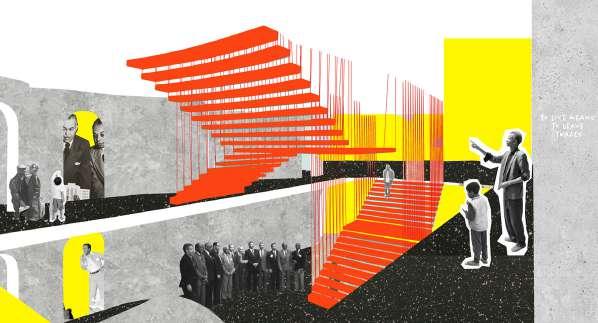





Jingqiao Jingding Tiandi
Software utilized: Rhino, Revit, Enscape
Participated in the Schematic Design (SD) phase and developed designs for sunken plaza.












Software utilized: AutoCAD, Revit
Participated in the Construction Document (CD) phase produced drawing for plan and interior elevation.


